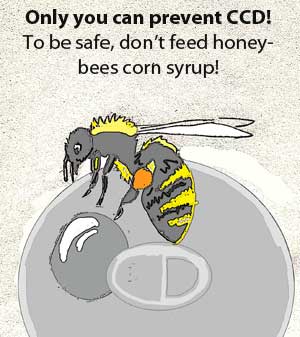Insecticides May Cause Honeybee Colony Collapse Disorder
Research suggests that the decline in honeybees is due to pesticide poisoning. Bees may receive some of the pesticide in their winter ration of corn syrup!
By Susan Fluegel, PHD
Recently attention has been drawn to the massive and mysterious die off of most of the honeybees in a hive. This is known as colony collapse disorder (CCD). In cases of CCD 30-90% of bees in a hive would disappear and be presumed dead. The worker bees simply flew off abandoning their queen and larva.
Worker bees are known for their devotion to queen and colony so this behavior was unfathomable. CCD has had scientists and beekeepers stumped and many logical as well as odd solutions to this problem have been proposed (everything from cell phone signals interfering with bee navigation to a build-up of bee diseases).
Research by Lu et al. (2012) suggests that the pesticide imidacloprid may be responsible for killing and disorienting bees. Imidacloprid is used on corn plants to kill insects and bees are often fed supplements of high fructose corn syrup. Bees are fed corn syrup so that the bee keepers can harvest the more valuable honey. Imidacloprid is able to move throughout the plant tissues so residues may be found in the corn syrup. The pesticide may also be found in flower nectar of the plants that bees are pollinating.
Imidacloprid is a neonicotinoid pesticide which disrupts the nervous system by mimicking acetylcholine, a neurotransmitter that signals nerves to fire. Acetylcholine is rapidly broken down by the enzymes after it signals. Acetylcholine mimics, such as imidacloprid, are not broken down by the body; they bind to nerves and cause them to fire continually. This can lead to overstimulation of the nervous system and death (Tomizawa and Casida 2005).
By the way, this process works exactly the same way in insects and in humans (Soderlund 2012). It just takes less pesticide to kill insects. Pesticides can have other less lethal effects. Kimura-Kuroda et al. (2012) reports that exposure to imidacloprid may harm developing brains.
To test imidacloprid’s effect on bees, Lu and other researchers set up 4 groups of bee colonies, each group had five hives. Four of the five hives received different amounts of imidacloprid dissolved in high fructose corn syrup. Doses mimic amounts of the pesticide that had previously been measured in the environment and ranged from 20 to 400 parts per billion imidacloprid. One hive in each group was a control hive and received no insecticide.
During the winter, when CCD usually occurs, bees abandoned 15 of the 16 hives that had received imidacloprid. Hives receiving the most imidacloprid died first. The hives had all the characteristics associated with CCD, including empty hives except for a few young bees and a sprinkling of dead bees. When hives die from other factors, such as disease or mites, more dead bees are found inside and outside the hive. Nearly all the hives that received no imidacloprid survived.
This study needs to be confirmed but right now it looks like imidacloprid and related pesticides are very likely contenders to cause honeybee die-off. Imidacloprid is a neurotoxin and could effect bee brain development and behavior causing bees to leave their hive, wander away confused and/or lose navigational skills. Check out Lu's original study here.
More indirect evidence for this research: Corn was not sprayed with imidacloprid until the year 2004/2005. Interestingly enough, the very next year bee colonies developed CCD.
How much of a problem is Colony Collapse Disorder (CCD)?
Honeybees pollinate over 1/3 of our food. Without pollination our food supply would decline precariously. According to the annual survey conducted by the U.S. Department of Agriculture (USDA) and the Bee Informed Partnership, 40.6% of honeybee hives suffered CCD in 2014/2015. Loses were spread over the summer and winter months.
The problem has not abated in 2015/2016, with beekeepers reporting colony hive losses of 44%. Due to the rapid decline in bee colonies, the price of bee hives is increasing rapidly. In 2015 the going rate of an 8-10 frame bee hive for pollination was $170-200.
CCD is a problem since bees pollinate so many of our food crops. In addition, bee hives dying means less honey for all of us who love honey!
Insecticide Exposure Stops Bees from Waggle Dancing!
Learn More to Help Bees!
References:
- Eiri DM, Nieh JC. A nicotinic acetylcholine receptor agonist affects honey bee sucrose responsiveness and decreases waggle dancing. Journal of Experimental Biology, 2012; 215: 2022. Pubmed. doi: 10.1242/jeb.068718
- Kimura-Kuroda J, Komuta Y, Kuroda Y, Hayashi M, Kawano H. Nicotine-like effects of the neonicotinoid insecticides acetamiprid and imidacloprid on cerebellar neurons from neonatal rats. PLoS One. 2012;7:e32432. Pubmed. doi: 10.1371/journal.pone.0032432 (full text)
- Lu C, Warchol KM, Callahan RA. In Situ Replication of Honey Bee Colony Collapse Disorder. Bulletin of Insectology, 2012;65:99-106. Full text.
- Soderlund DM. Molecular mechanisms of pyrethroid insecticide neurotoxicity: recent advances. Arch Toxicol. 2012;86:165-81. Pubmed. doi: 10.1007/s00204-011-0726-x (full text)
- Tomizawa M, Casida JE. Neonicotinoid insecticide toxicology: mechanisms of selective action. Annu Rev Pharmacol Toxicol. 2005;45:247-68. Pubmed.

